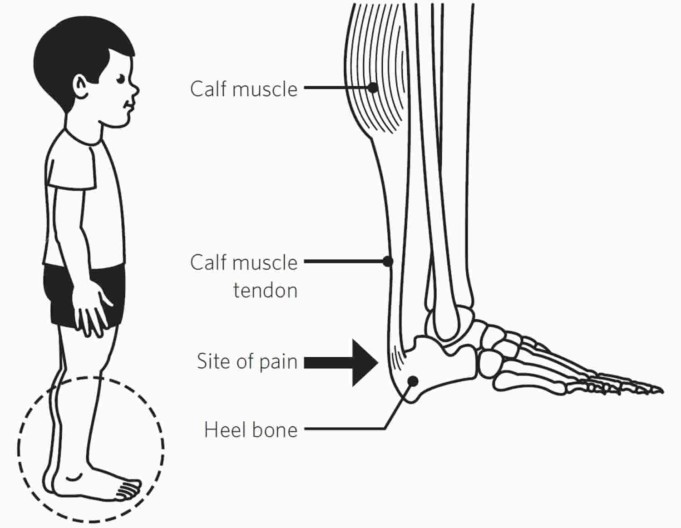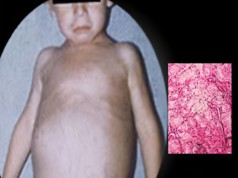Sever’s disease is a condition mostly affecting young male adults. It is also medically known as calcaneal apophysitis. Sever’s disease is an instance of bone injury that is characterized by the growth of plate in the lower back of the heel, a location of the familiar Achilles tendon; the heel cord that holds unto the growth plate. In this bone condition, the Achilles tendon becomes inflamed and this results in serious pains.
This inflammation is as a result of over exhaustion or excessive blow to the growth plate of the heel.
This growth plate, also known as an epiphyseal plate or a physis, is an area located at the end the bones of children and adolescents. It seves in producing new tissues in order for the bone to grow and develop in shape.
This painful inflammation of the calcaneal apophysis, which mostly affects children between the ages of 9 to 12 years; a period of active growth in adolescent with symptoms frequently unilateral, but up to 50% of cases can present with bilateral pain.
As earlier mentioned, Sever’s disease occur usually in males, presenting most frequently at an average age of 12 years for males and 11 years for females.
Youngsters always affected with this condition are usually involved in sports requiring constant running and jumping such as track races, football, basketball, cross country and gymnastics, was first described in 1912 by an American orthopedic doctor named James Warren Sever (1878-1964).
He first mentioned the condition in his article “The Principle of Orthopedic Surgery”, published in 1940 through the Macmillan Company.
Risk Factor of Sever’s Disease
Sever’s disease can result from an umbrella of factors that can lead to injury after a certain period of time, such factors include long or year-round activities, poorly fitting and worn-out footwear or poor training mechanics.
Additionally, biomechanical factors such as poor heel cord flexibility, pes cavus (high arch), pes planus (flat feet), genu varum (Bowleggedness) or forefoot varus can predispose victims to the development of Sever’s condition.
As time passes, the back of the heel hardens and becomes tougher when it finishes growing, which is why Sever’s rarely occurs in older adolescents and teenagers.
Causes of Sever’s Disease
During the growing process in humans, the heel bone of the young citizens grows faster than the ligaments in the leg. In fact, the heel is one of the first body parts to reach full adult size; when the muscles and tendons are not able to keep up with this growth and so they are stretched too tight.
This makes the heel easily susceptible to injury since it is not very flexible. Sever’s disease occurs as result of continuous and consecutive stress on the Achilles tendon.
With time, this constant pressure on the already stretched thinned heel cord can damage the growth plate resulting in pain and inflammation (swelling).
Such stresses and pressures can be as a result of the following:
- Sports that entail running and jumping on particularly hard surfaces
- Standing too long, which puts constant pressure on the heels.
- Poor fitting shoes that do not provide enough support and padding for the feet.
- Exercising too much
In a particular study of injuries among young athletes aged 9 to 19 years who mostly played soccer, it was found that Sever’s disease accounted for 2% of soccer injuries, with children of 11years been most likely affected.
Though previously thought to affect mostly males, recently, it has been found to equally affect females due to the increase of girls in sports participation.
Some other biological factors might also be associated with Sever’s disease, such as:
- Flat or high arches feet
- Pronated foot: having one’s foot twisted so that if walking, the weight would be borne on the inner edge of the foot, a poor walking posture.
- Having one leg shorter than the other.
- Obesity or being overweight.
Symptoms of Sever’s Disease
Sever’s disease is mostly characterized by pain and tenderness in one or both heels usually occurring at the back of the heel but can also extend to the sides and bottom of the heel as observed in few cases.
This pain tends to worsen during physical and movement activities with the legs. A child with Sever’s condition may also experience these common symptoms:
- Pain Swelling and redness in the heel of one or both feet.
- Difficulty walking or running with a limp or on tiptoes.
- Heel pain observed with limping especially after running.
- Stiffness in the feet upon awaking
- Limited ankle dorsiflexion range secondary to tightness of the Achilles tendon
The pain gradually resolves with rest. All sports activity that includes running should be discontinued while the ward has heel pain.
Diagnosis of Sever’s Disease
Sever’s disease is usually diagnosed by clinicians by examining the medical history of the patient and physically examining the presented symptoms.
The clinician supervising the condition physically examines the patient by observing for:
- Passive dorsiflexion test of the ankle: This test may also provoke a painful reaction; it shows a decrease in dorsiflexion.
- Tenderness on palpation.
- Overweight
- Squeeze test: The test involves the doctor squeezing the back of the heel to check if it hurts. The patient may be asked to stand on their toes, to see if other symptoms occur. It is performed over the lower one-third of the posterior calcaneus and important to diagnose calcaneal apophysitis.
- Biomechanical abnormalities: forefoot varus, raee foot varus, pes valgoplanus, pes planus and hallux valgus.
- Swelling and other skin changes are indicators for different pathologic conditions and are uncommon for Sever’s disease. However, mild swelling may be observed.
- Gait: the patient may walk with a limp or exhibit a forceful heel strike.
Imaging tests such as X-rays are not typically used to diagnose Sever’s disease as results still shows up as normal. However, a doctor may order an X-ray to rule other foot condition (differential diagnoses) and injuries such as fractures.
Differential Diagnoses: Posterior heel pain can occur due to other conditions, such as:
- Heel Spur
- Haglund’s Deformity
- Achilles Tendinopathy
- Retrocalcaneal Bursitis
- Heel Pad Syndrome
- Calcaneal Stress Fracture
Treatment of Sever’s Disease
Sever’s disease is a condition that does not causes any long-term foot problems. Symptoms usually go away within few months. The primary method of treating sever’s disease is resting and taking time off from sports and other physical activities to alleviate the pressure on the heel bone.
During the healing process, the clinician might also recommend; physical therapy or any type of exercise that involves stretching and strengthening leg muscles and tendons, supportive shoes and inserts that reduce stress on the heel bone; this also help the patient if he/she is suffering from any other foot problem that aggravates Sever’s disease, such as flat feet or high arches, wrapping with ice packs or use of non-steroidal anti-inflammatory drugs (NSAIDs).
In severe cases, the patients may need a cast, so their heel is forced to rest.
Prevention of Sever’s Disease
It is very usual for Sever’s disease to reoccur after the first occurrence because once the first growth spurt ends, and the child reaches full size, the Sever’s disease would not return.
Until then, the disease can occur again if the child stays very active. Some simple steps can prevent it, Have the child:
- Wear supportive, shock-absorbing shoes.
- Stretch their calves, heels and hamstrings.
- Try to avoid lots of running and pounding on hard surfaces.
- Avoid strenuous trainings and exercise, and suggest plenty of rest, especially if they begin to feel pain in the heels.
- If overweight, they should be assisted to lose some extra pounds, which can increase pressure on their heels.
Summary
Experts in Orthopedic Center provides comprehensive assessment, treatment and follow-up young wards, adolescents and young adults with Sever’s disease and other related issues of the musculoskeletal system.
The lower extremity Program’s skilled clinicians and sports medicine experts work with physical therapy staff to deliver comprehensive evaluation and long-term treatment plans.
Medical sports Division experts in health centers like the Boston Children’s Hospital have recently developed innovative evaluation programs and effective injury prevention programs and strategies.
Together, they provide the ward with expert diagnosis, treatment, and care- as well as the benefits of some of the most advanced clinical and scientific research in the world.
Sources;
- Causes and Symptoms of sever disease; https://www.chortho.com/common-conditions/severs-disease
- Sever Disease; http://orthoinfo.aaos.org/en/diseases–conditions/severs-disease/
- Server’s Disease; http://www.physio-pedia.com/Sever%27s_Disease












